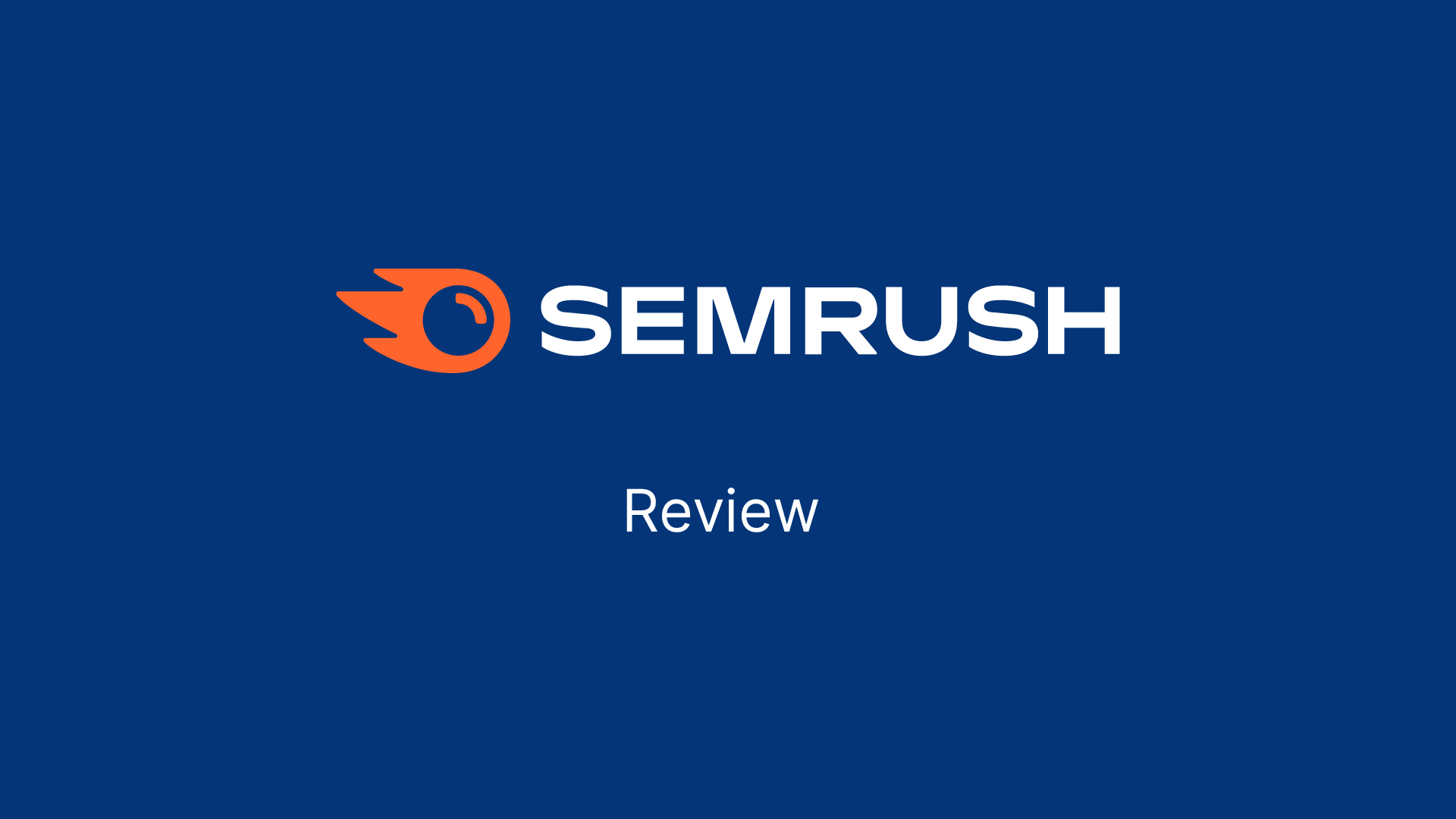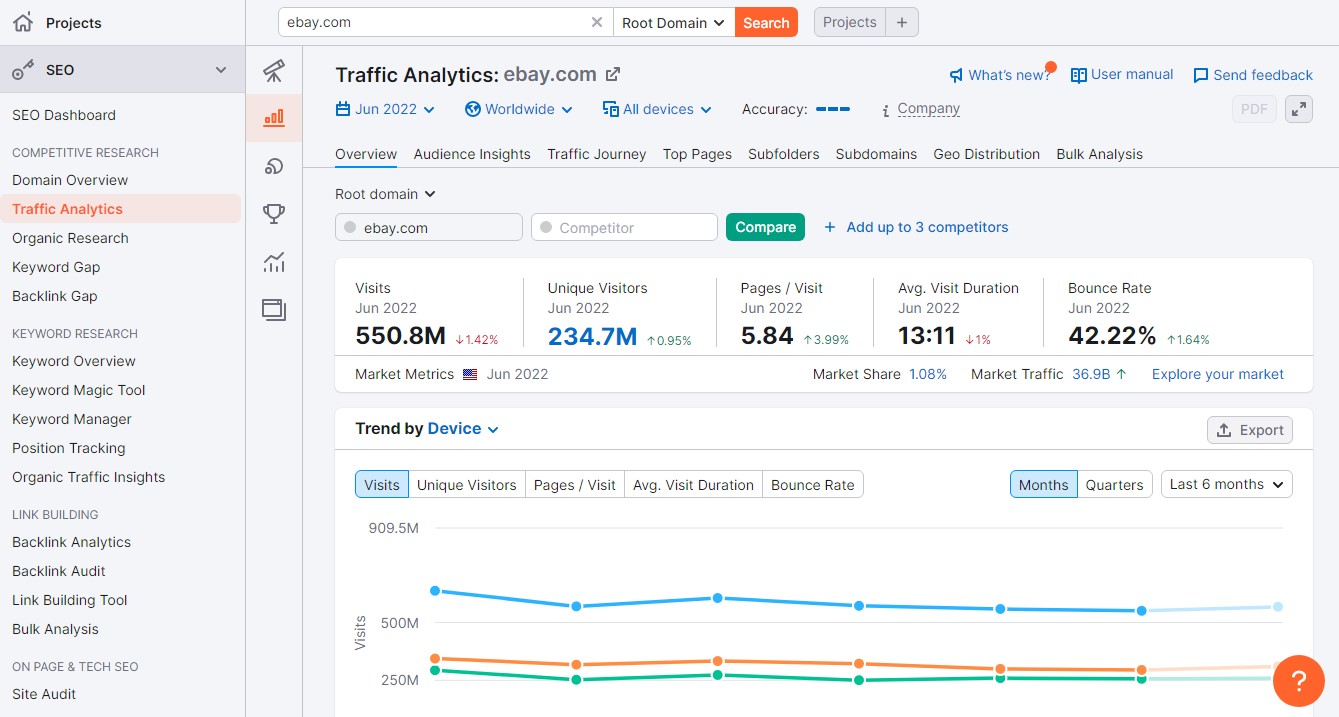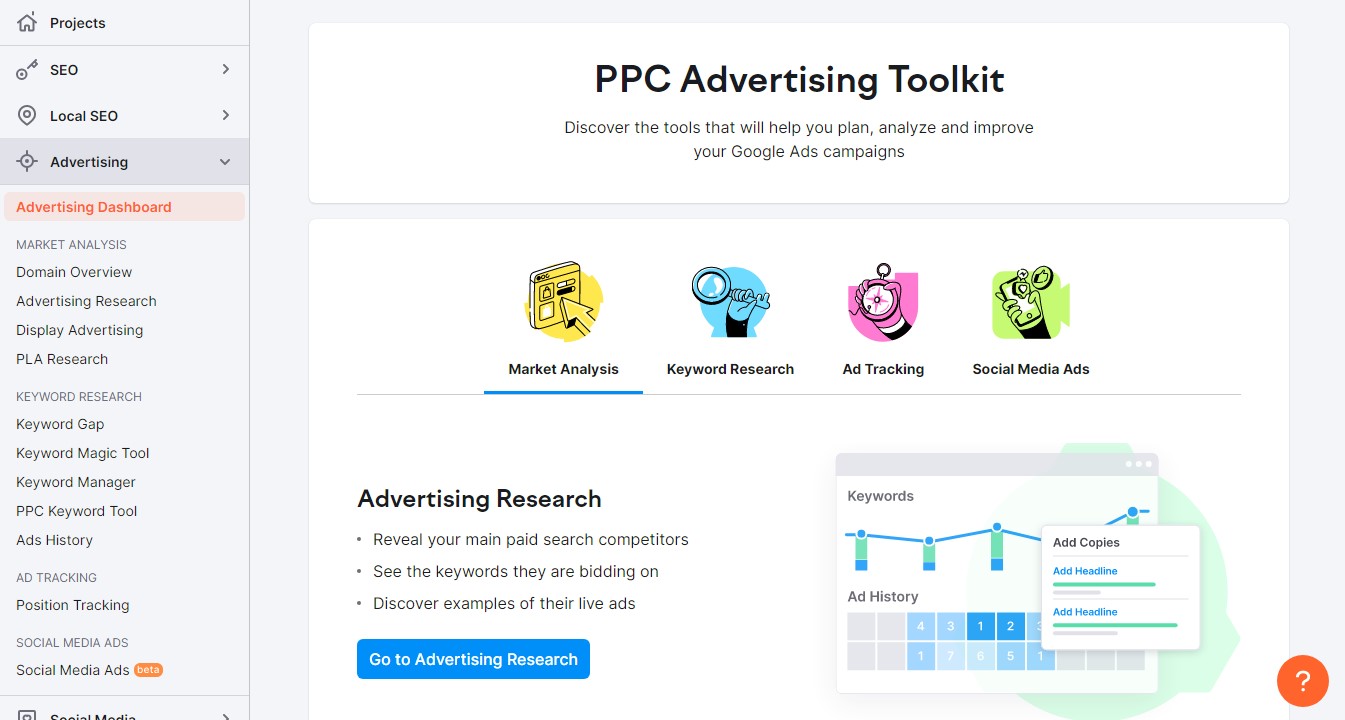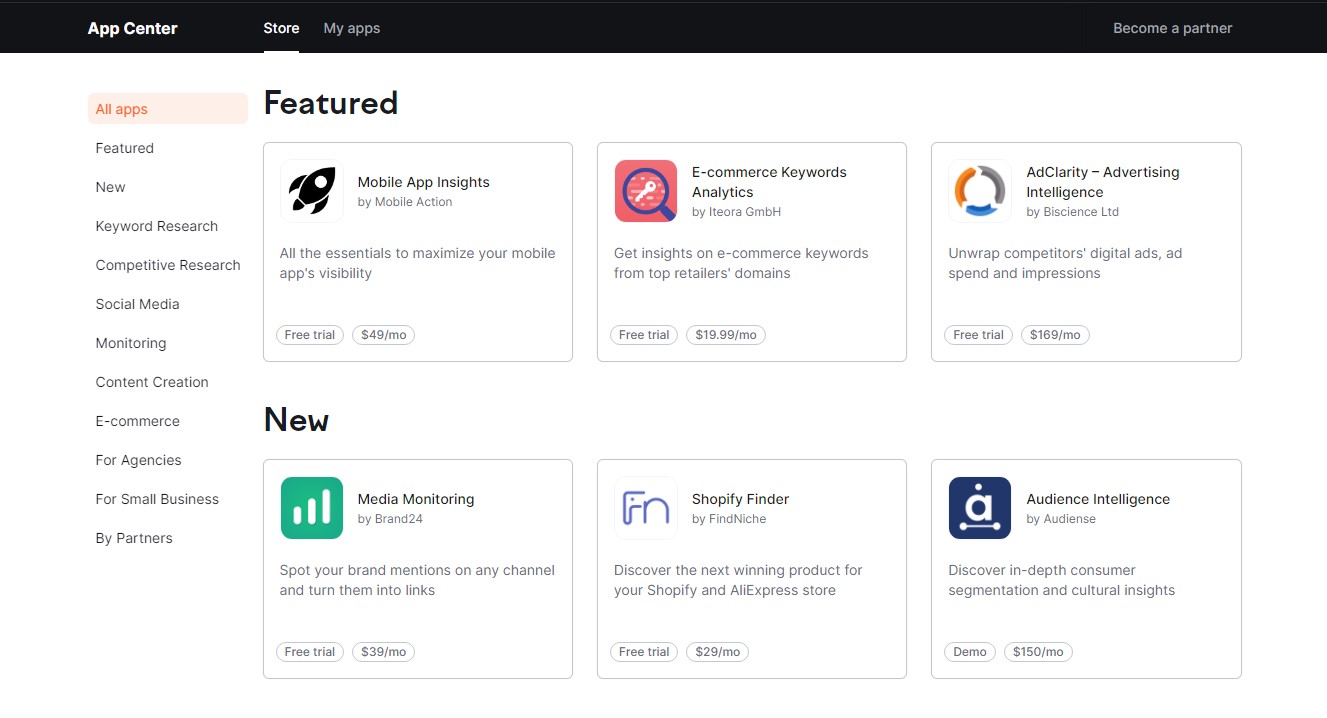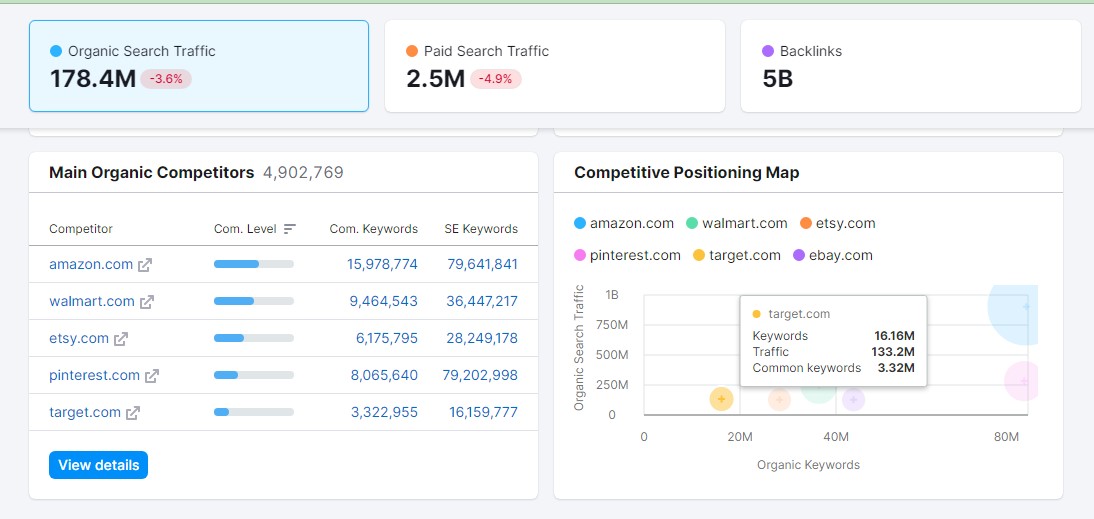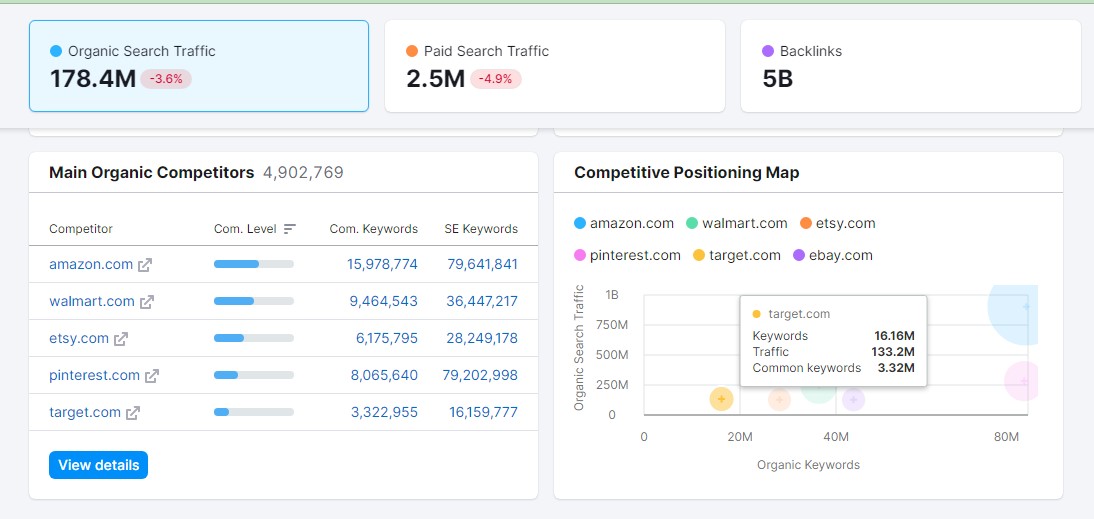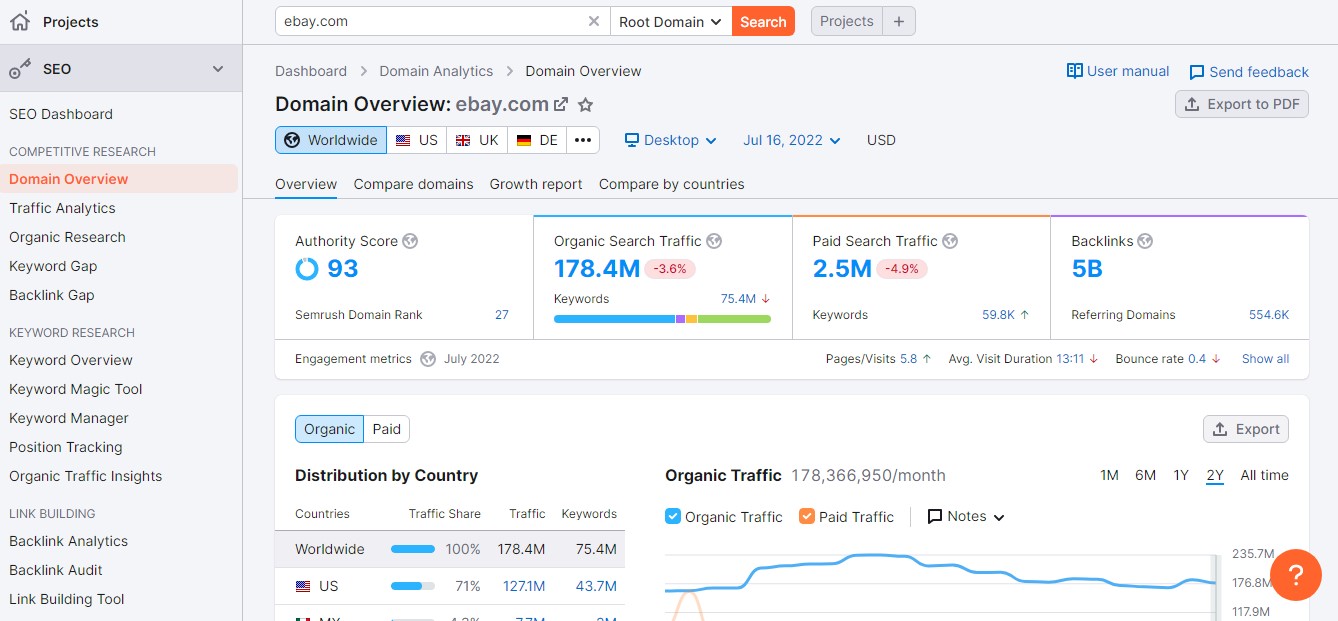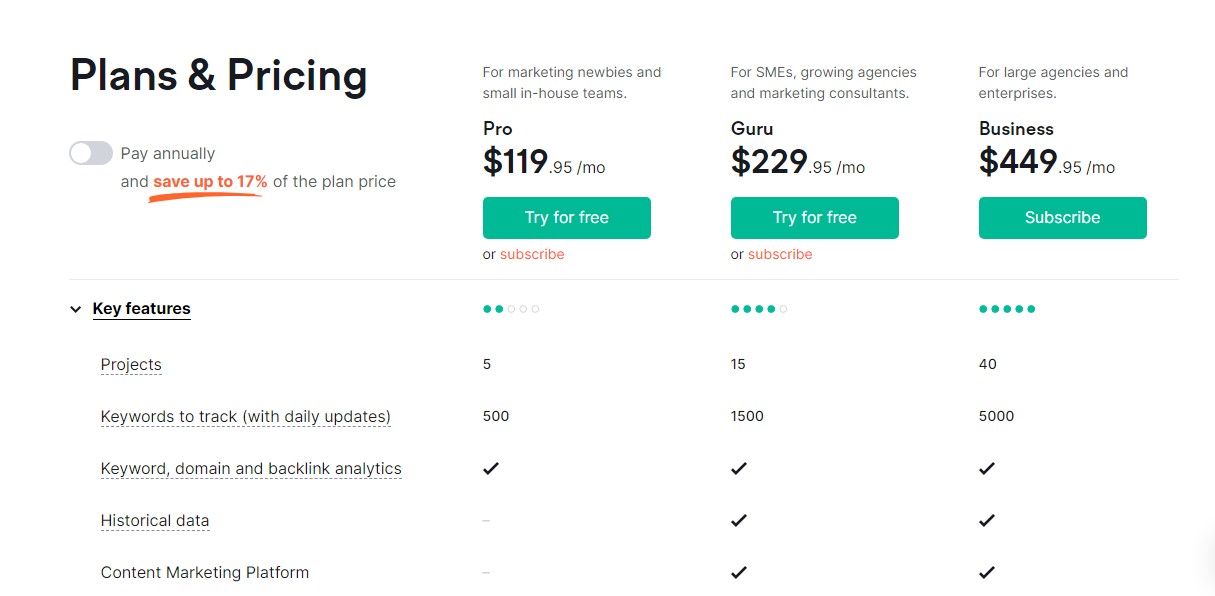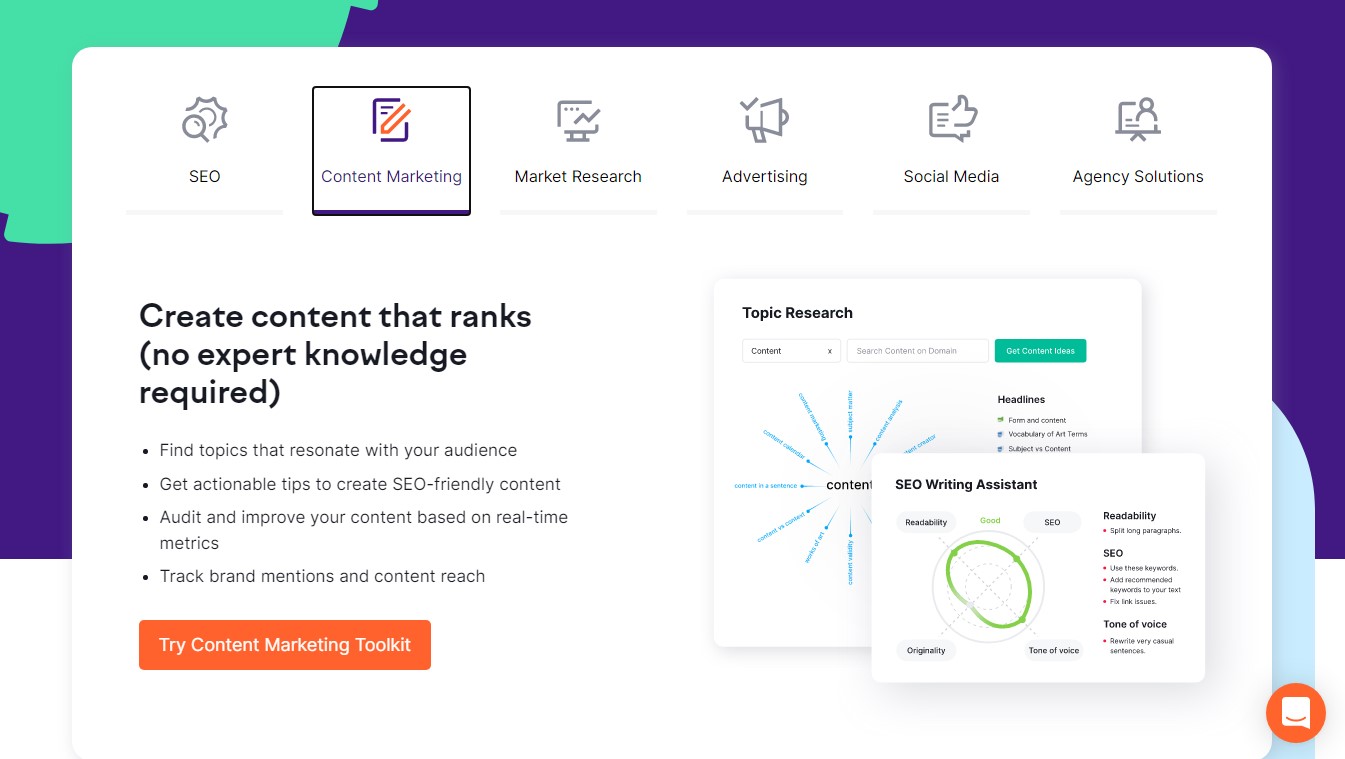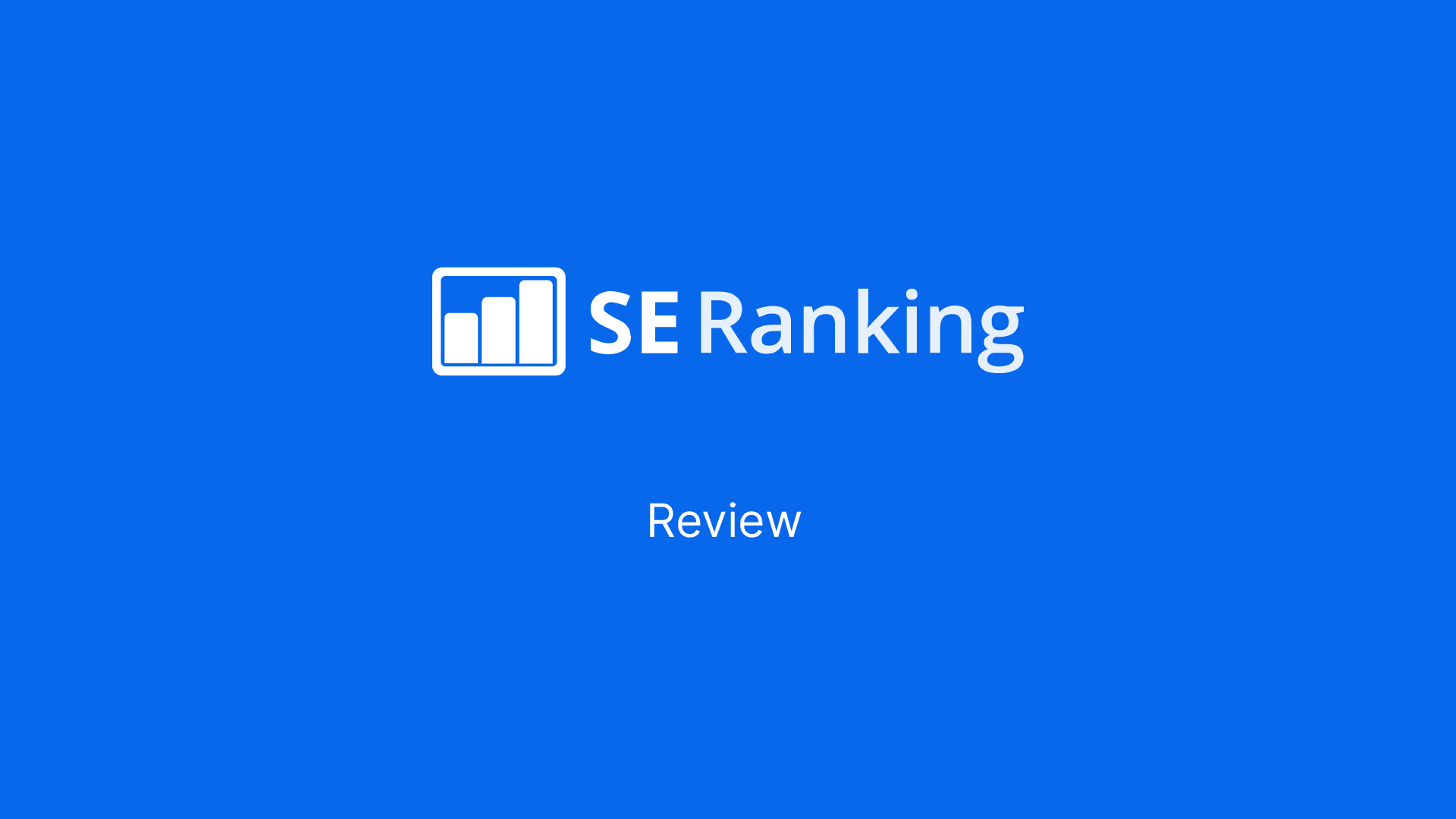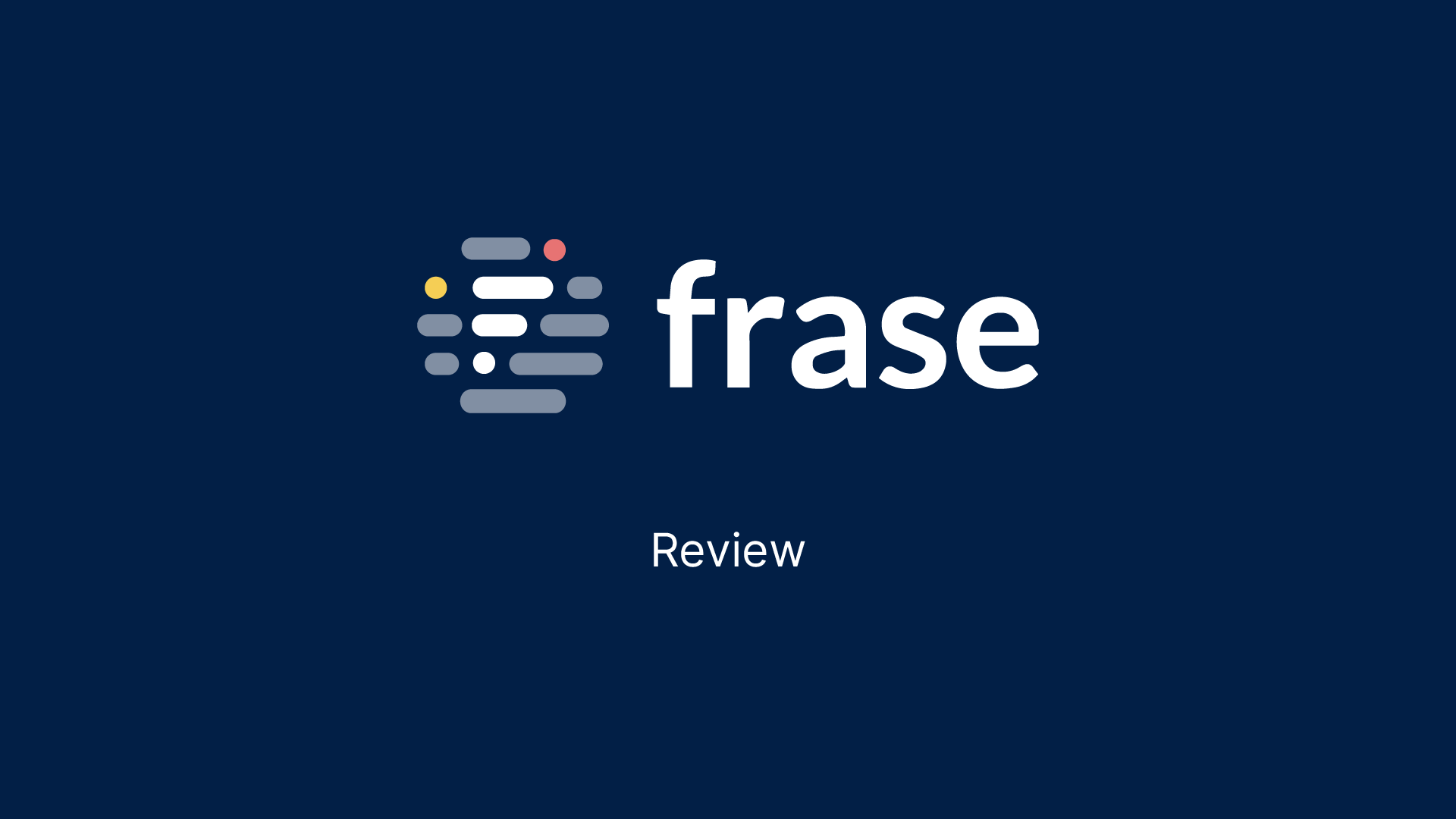SEMRush is an all-in-one tool that allows you to analyze your site’s traffic, keywords, backlinks, competitors, and even social media presence. It also provides information about your audience, including demographics, interests, and behavior patterns. With SEMRush, you can see what your visitors are searching for, and you can even create custom reports to show exactly what you need. What makes the platform even greater is the ease of managing and growing your backlink profile.
Are you looking for a way to increase traffic to your site? If yes, then SEMrush is one of the best SEO tools out there for you. This software helps you analyze competitors’ backlinks, find keywords everywhere, and much more.
Search Engine Optimization (SEO) has become a crucial part of every business strategy. In order to rank higher in Google searches, businesses need to invest time and resources into their websites.
With over 20 million downloads worldwide, SEMrush is the go-to SEO tool for SEO professionals. Its features include keyword research, competitor analysis, link building, social media monitoring, and more.
In this review, we will have a closer look at these features and how you can optimize your website using these great tool kits.
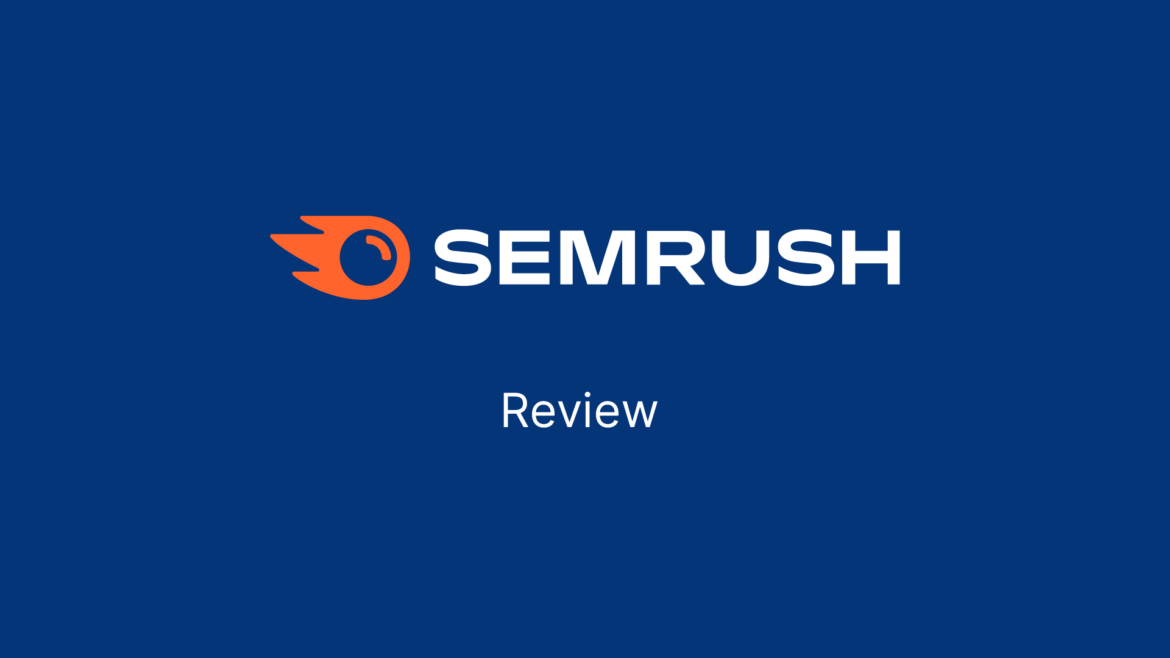
Disclaimer: Note that some links and banners in this article are affiliate links, which provide us with a small commission if you complete purchases via those links. You can read the affiliate disclosure of our privacy policy in the footer.
What is SEMRush?
SEMRush is a comprehensive digital marketing platform that offers a wide range of tools and features to help businesses and individuals improve their online presence, drive more traffic, and increase conversions.
It is an all-in-one SEO solution that provides users with the ability to conduct keyword research, analyze competitors, track rankings, and optimize their website for better search engine visibility.
Whether you’re a seasoned SEO professional or just starting out, SEMRush equips you with the necessary tools to understand and enhance your website’s performance.
From identifying the best keywords to target to analyzing your competitors’ strategies, SEMRush covers all aspects of digital marketing. Its robust suite of features includes keyword research tools, backlink analytics, site audits, and much more, making it an indispensable resource for anyone looking to succeed online.
SEMRush Benefits
SEMRush offers a variety of benefits to its users, including:
Improved Website Visibility
One of the primary benefits of using SEMRush is the significant improvement in your website’s visibility on search engine results pages (SERPs).
SEMRush provides a comprehensive suite of SEO tools that enable you to conduct in-depth keyword research, analyze your competitors, and identify opportunities to enhance your website’s search engine rankings.
By leveraging these insights, you can optimize your website’s content and structure, ensuring it ranks higher for relevant search terms and attracts more organic traffic.
The Benefit of Organic Research Reports in SEMRush
SEMRush’s Organic Research Reports are a treasure trove of valuable insights that can help you understand and improve your website’s organic search performance.
These reports provide detailed information about the keywords driving the most traffic to your site, the pages receiving the most visits, and the strategies your competitors are using to rank for similar keywords.
With this data, you can fine-tune your SEO strategy to target high-performing keywords and optimize your content for better search engine rankings.
In addition to Organic Research Reports, SEMRush offers a plethora of other tools and features designed to enhance your digital marketing efforts:
Keyword Magic Tool: This powerful keyword research tool generates a comprehensive list of relevant keywords and phrases, helping you identify the best terms to target for your SEO campaigns.
SEO Tools: SEMRush’s suite of SEO tools includes a site audit tool, a technical SEO audit tool, and a backlink analytics tool, all designed to help you optimize your website for better search engine rankings.
Google Analytics Integration: Seamlessly integrate your Google Analytics account with SEMRush to track your website’s traffic and conversion rates, gaining deeper insights into your site’s performance.
Content Marketing Toolkit: Create and optimize high-quality content with SEMRush’s content marketing toolkit, which includes an SEO writing assistant to ensure your content is search engine-friendly.
Domain Overview: Get a comprehensive overview of your website’s online presence, including domain authority, backlink profile, and organic search traffic, with the Domain Overview tool.
SEO Toolkit: SEMRush’s SEO toolkit provides all the tools you need to optimize your website, from site audits to backlink analysis.
SEO and PPC Campaigns: Manage and optimize your SEO and PPC campaigns from a single dashboard, streamlining your digital marketing efforts.
Traffic Analytics: Gain insights into your website’s traffic sources, the pages receiving the most visits, and the keywords driving the most traffic with SEMRush’s Traffic Analytics tool.
SEMRush SEO Writing Assistant: Optimize your content for better search engine rankings with the SEO Writing Assistant, which provides real-time suggestions for improving your content.
Backlink Analytics: Analyze your website’s backlink profile, including the number of backlinks, their quality, and anchor text distribution, with the Backlink Analytics tool.
SEO Writing Assistant: Ensure your content is optimized for search engines with the SEO Writing Assistant, which offers suggestions for improving your content’s SEO.
Seed Keyword: Identify relevant keywords and phrases to target with the Seed Keyword tool, helping you build a strong keyword strategy.
SEO Strategy: Develop a comprehensive SEO strategy with SEMRush’s tools, including site audits, technical SEO audits, and backlink analytics reports.
Keyword Ideas: Generate a list of relevant keywords and phrases to target with the Keyword Ideas tool, helping you expand your keyword portfolio.
Keyword Research Tool: Conduct in-depth keyword research and identify the best keywords to target with SEMRush’s Keyword Research Tool.
Link Building Tool: Build high-quality backlinks to your website with SEMRush’s Link Building Tool, enhancing your site’s authority and search engine rankings.
Content Marketing Tools: Create and optimize content for better search engine rankings with SEMRush’s suite of content marketing tools, including the content marketing toolkit and SEO writing assistant.
Keyword Overview Tool: Get a comprehensive overview of your website’s keyword profile with the Keyword Overview Tool, including the keywords driving the most traffic and the competitors ranking for the same terms.
By leveraging these tools and features, you can develop a robust SEO strategy, improve your website’s visibility, and drive more organic traffic to your site.
Who is SEMRush Best for?
SEMRush is great for SEOs who want to know what works on google so that they get their website to rank.
The tool provides detailed information about what keywords are popular, which ones are losing traffic, and which ones are gaining popularity, thereby improving your search engine visibility. It also shows you where your competitors rank for specific keywords and allows you to compare yourself against them.
It helps you know what keywords they should be targeting. The tool also provides information about how much competition each keyword has, which helps you decide whether or not to invest money into that particular search term.
Internet marketers benefit from SEMRush because it has everything you need to manage digital marketing campaigns, from SEO, Paid ad campaigns, Content marketing and Social Media marketing.
What Does SEMRush do?
SEMrush is a comprehensive digital marketing research platform that allows you to see what keywords your competitors are ranking for, what pages they’re targeting, and how many conversions they’re getting.
You’ll also get access to detailed reports about your competitors’ backlinks, traffic sources, social media activity, and more, all of which can help you increase your organic search traffic. All of this information is available right within the platform, making it incredibly easy to create a winning SEO strategy.
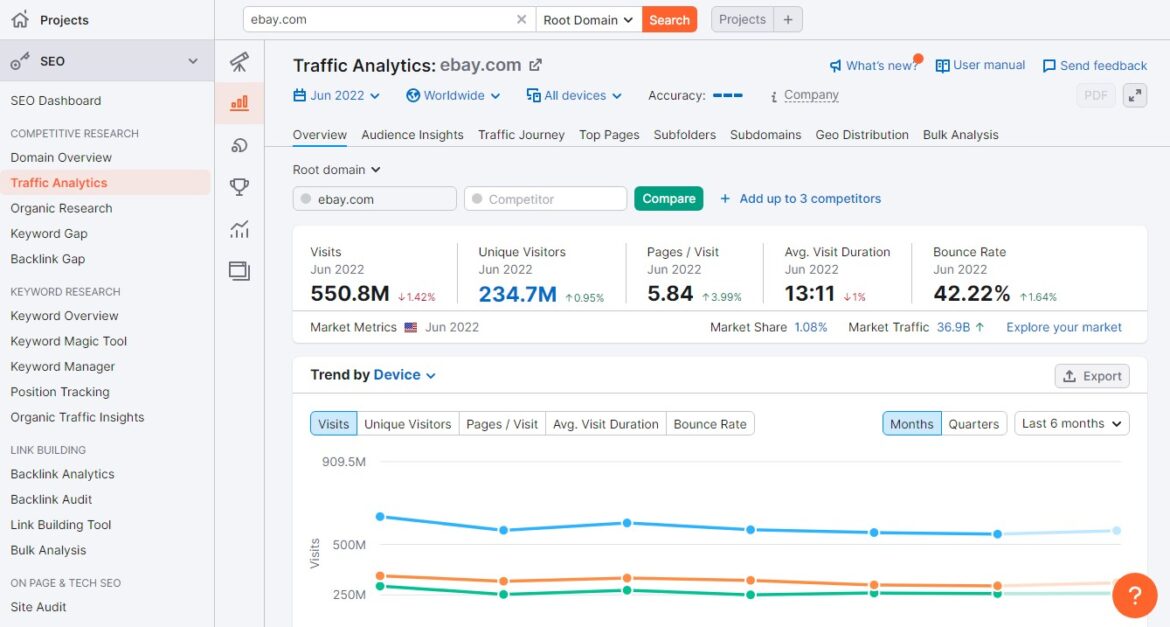
SEMrush is an SEO tool that helps businesses understand what keywords to target and which sites to focus on. It also shows you how to optimize your site for each keyword.
It gives you access to a ton of tools like Keyword Suggestion Tool, Competitor Analysis, Backlinks Checker, Site Audit, Social Media Analytics, etc.
I’ve done a detailed review of SEMrush and share all the best features of SEMrush below. This review comes from m experience having used the platform to improve our website position ranking on google and more.
SEMrush’s SEO Toolkit (SEO Features)
SEMRush’s Value lies in the range of features it offers to make your website rank in search results.
The SEO toolkit is packed with these SEO features and tools to help you through the processes of optimizing your website’s organic search traffic. The SEO toolkit has about 20 features to work with.
With The SEO Toolkit, you can monitor your website’s visibility online and collect SEO data, research competitors, analyze your website pages for new keywords and content ideas, and build links to your website.
Let’s take a look at these features.
Domain Overview
Domain Overview provides a range of overview metrics for a domain’s web presence so you can quickly get an idea of its overall online visibility. You’ll be able to see the domain’s organic and paid search traffic and backlinks. You can access the different data modules from the Domain Overview page by clicking on them.
Domain analysis is a great way to see what kind of traffic a particular website gets. You can check out the top keywords that people are searching for when they visit a certain website.
If there is a lot of interest in a particular topic, then it could be a good idea to reach out to the owners of that site and ask them to add a backlink to your website.
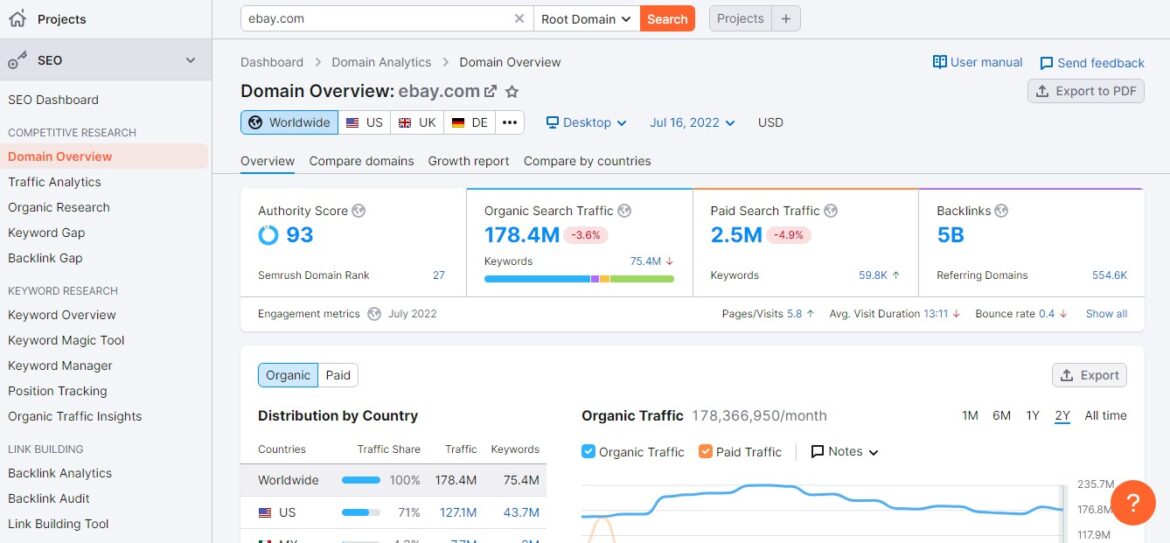
Metrics provided include an Authority ‘rank score’. The total number of visits to the website per month, and the average time spent on the site. The total number of backlinks pointing to the website. Keywords the website ranks for, along with the search intent behind them. Anchor texts that are commonly used in links to your website.
With domain analysis, Semrush provides an overview of your website’s authority, its competitors’ rankings, and what keywords they’re ranking for. You can also see how many backlinks each page receives and the amount of organic traffic each page generates.
They have made it easier to understand your website traffic data. They’ve added a graph at the top of the page showing the number of monthly visits to your site over time. You’ll also see a breakdown of those visits into daily, weekly, and monthly totals.
Semrush provides a lot of information about your website from domain analysis. You can see what keywords are driving traffic to your site, how many visitors you get per month, and how many pages your site has. These numbers give you a sense of how well your site is performing, and if there are any areas that need improvement.
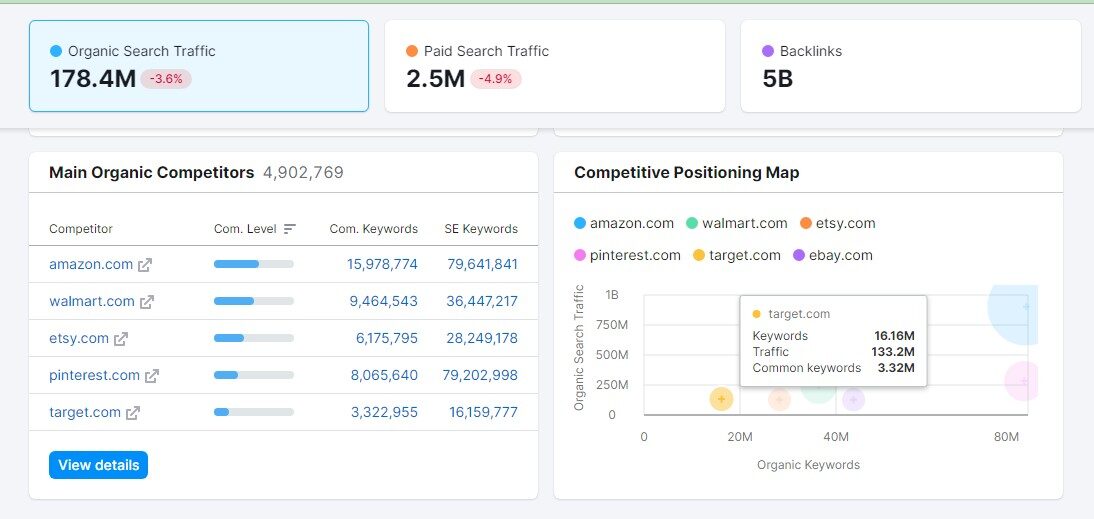
There are also several other metrics available, including social media mentions, backlink analysis, and even a keyword difficulty score. All of these metrics provide insight into your site’s strengths and weaknesses, helping you understand what needs to change to increase its overall performance.
What does Domain Overview give you?
An overview of any domain‘s overall search engine presence – estimated organic and paid traffic and the number of backlinks.
An instant analysis of a website‘s top performing keywords – organic positions, recently changed positions, keyword intent, advertising words, and more
There are several options available for analyzing global and mobile database systems.
Use Semrush to collect previews of the deeper competitive analysis reports on Google Ads.
Ability to research a specific domain, subdomain, folder, or URL
Analyze a Growth Report of a domain’s performance over a period of time.
This tool is great if you’re looking to understand what your competition is doing, but it doesn’t tell you anything about how well you’re doing compared to them. You need to dig deeper to find out how you compare to other sites.
You can also see at a glance what pages your competitors rank for, and whether there are any obvious gaps in your own rankings.
SEMRush doesn’t show any traffic costs because it is not a paid tool. However, there are other free tools that provide similar information. For example, Ahrefs shows traffic costs alongside its organic search results.
If you want to know how much it would actually cost to purchase ads that generate an equivalent amount of traffic, you can check out SEMRush’s Domain Overview Analysis section.
In terms of SEO, the Domain Overview section of SEMRush is very useful. On its own, it provides a great insight into how your site is performing from an SEO perspective.
Keyword Research in SEMRush
SEMRush makes it very easy to find out all the information you need to write content that ranks. You just need to enter your keywords and then click on the “Search Keywords” button.
After that, you will see all the results along with the number of organic search traffic per month, keyword difficulty level, competition, etc.
Keyword research is about getting an idea of what keywords your competitors are using. You can then use those keywords to help you rank higher in search results.
There are lots of tools available to help you find out how many people are searching for different keywords. Some of them also give suggestions on what keywords you should add to your site. This helps you to stay ahead of your competition.
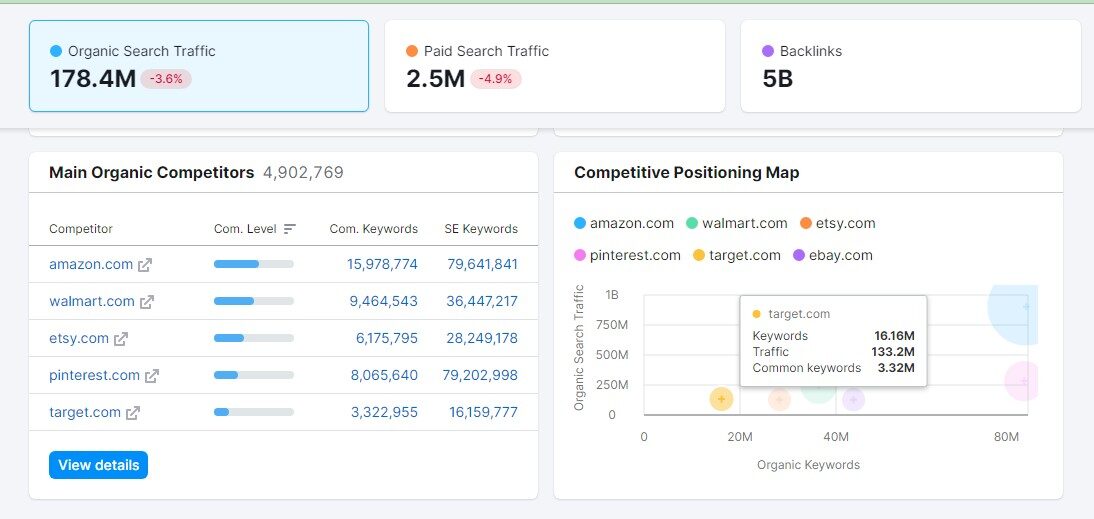
Accessing basic keyword data
SEMRush offers free access to its tools, including Keyword Overview gives you access to additional features like Keyword Difficulty Score, Competitor Analysis, Citation Flow, and more. You also get some suggestions for alternative keywords to target.
As with domain analysis, you could also do this on a per-country level, which is helpful. One of the most important metrics returned here is the keyword Difficulty Score. SEMRush uses a Percentage to indicate this – with a higher percentage indicating it’s going to be easier to rank for a particular word.
SEMRush provides an easy way to see what links you need to get to rank for your target keyword. You simply enter the keyword you wish to rank for and then select the number of times you’d like to rank for that term.
Then click “See Results”. You’ll see a list of all the pages that link to your site. These are the pages that you need to add to your website in order to increase your ranking.
This new feature works great, except when it doesn’t. Sometimes SEMRush h doesn’t output what you think you should get back for a specific keyword. Instead, you’ll get a vague statement like “on-page SEO, link building, content promotion efforts” that will help you rank.
SEMRush is a great SEO tool because it provides you with all the tools you need to rank your website higher on Google. You can check out our blog post about the best free SEO tools here.
Keyword suggestions
SEMRush Keyword Suggestions is an incredibly useful tool. You can enter any search term and see what keywords will help your site rank higher on Google. You can also see what keywords are already ranking well for your competitors. If you’re looking for ideas for your next blog post, this essential tool is a great place to start!
It provides a list of relevant search terms that are related to your query. You can filter the list by any number of criteria, including the number of monthly searches, cost per click, and keyword difficulty. If you’re looking for an answer to a specific question, you can also sort the results by relevance.
SEMRush offers many features to help you get started. One of them is the Keyword Magic Tool. This tool allows you to see what keywords are easiest to rank for. By using the drop-down menu, you can easily choose your level of difficulty and then see the keywords suggested by the tool.
SEMRush helps you identify the keywords that you can actually rank for in search engine results pages.
You can use filters to narrow down your list, including the number of monthly searches for each keyword, words to exclude, and whether or not the suggested keywords should match your entered phrase exactly. There’s even a beta filter that allows you to filter by language.
This tool is great because it gives you an idea about what kind of search terms will bring users to your site. You can also see if there are any negative keywords associated with those terms.
Negative keywords help keep your website safe from unwanted visitors. For example, if someone searches for “best dog food,” you might not want your page to show up when they type in “dog food review.”
Informational the user wants to find a solution to a problem.
Commercial the user wants to buy something.
Navigational the user wants a link to go somewhere else.
Transactional the user wants to pay someone or get paid.
This feature gives you more information about your keywords than just search volume alone. You can also see what other advertisers are bidding on those keywords, and choose to bid on them yourself if you think you can get higher bids.
If you’re looking for commercial keywords, you can even choose to exclude all non-commercial keywords from your campaigns.
Keywords Manager
The Keyword Manager Is only available with a paid subscription. It helps you analyze up to 1,000 words at a time. You can use it in real time to check whether any SERP features or top competitors for a specific keyword have changed since our last update.
It gives you the basic data for your keywords like search intent, volume, trend, CPC, KD, SERP features, click potential, and your top competitors for your keywords.
You can also choose which keywords you want to track by adding them manually to the keyword manager form the keyword overview feature.
The Benefit of Organic Reseach Reports in SEMRush
Understanding what your competitors are doing right and what opportunities there are to improve your own site is one of the most important steps when running an SEO campaign. These reports give you important information for a competitive analysis, which helps you plan a campaign to increase traffic to your website.
You can use these reports to gather research about your competitors, but you might also want to check out their Keyword Gap tool, backlinks, traffic analytics, and sensor. Each of these tools also helps you perform competitive analysis.
All Organic Research reports except the Overview let you export your data so you can use it later. If you’re looking for something to help you do additional research within an Excel document, this is great.
You can click the Export button in the top right corner of your list of keywords to export the Positions, Competitors, Pages, and Subdomain reports. etc.
SEMRush offers a range of services including SEO analysis, backlink checker, competitor analysis, social media monitoring, website speed optimization, and more.
You can access all of these features through the free version of the tool, however, if you wish to get full access to all of the features, you will need to upgrade to a paid subscription.
The Keyword Gap Feature
Keyword Gap offers a side-by-side comparison between competitor’s keyword profiles. You can compare up to five websites at once using this tool to see which keywords are missing from your site that your competitors are ranking for.
You just need to enter the domain names and choose the type of ranking you want to analyze. The report will then give you all of the top potential opportunities for each site, the total keyword overlap, common words shared by all sites, etc.
This insight on keywords your competitors are using is super helpful for planning an SEO campaign because you can see exactly where your best opportunities lie in your niches.
Instant SEO competitive analysis between you and your top competitors.
You can see the unique keywords your competitors are ranking for that you aren’t.
Organic, paid, and Google Shopping (PLA) analysis
Keyword overlap charts show which keywords are most important for each site.
Ability to compare mobile and desktop keywords
Ability to compare sub domains, sub folders, and URLs (available only with a Guru or Business subscription).
Advanced filters for quick keyword research (position, keyword difficulty, intent, and more).
SEMRush’s Content Marketing Toolkit
SEMRush’s content marketing tool helps you create high-quality content that will help your website rank higher on Google through effective content optimization. You can easily copy and paste content from there into your own blog posts or articles. It even gives you suggestions on how you can improve your content.
Through its machine-learning ai, SEMRush makes suggestions for the length of your blog, and what keywords to include in your content.
To make writing content easier for your SEMRush can create draft research for you collecting content from the top 10 results so you can start working on your blog using content that already ranks on google.
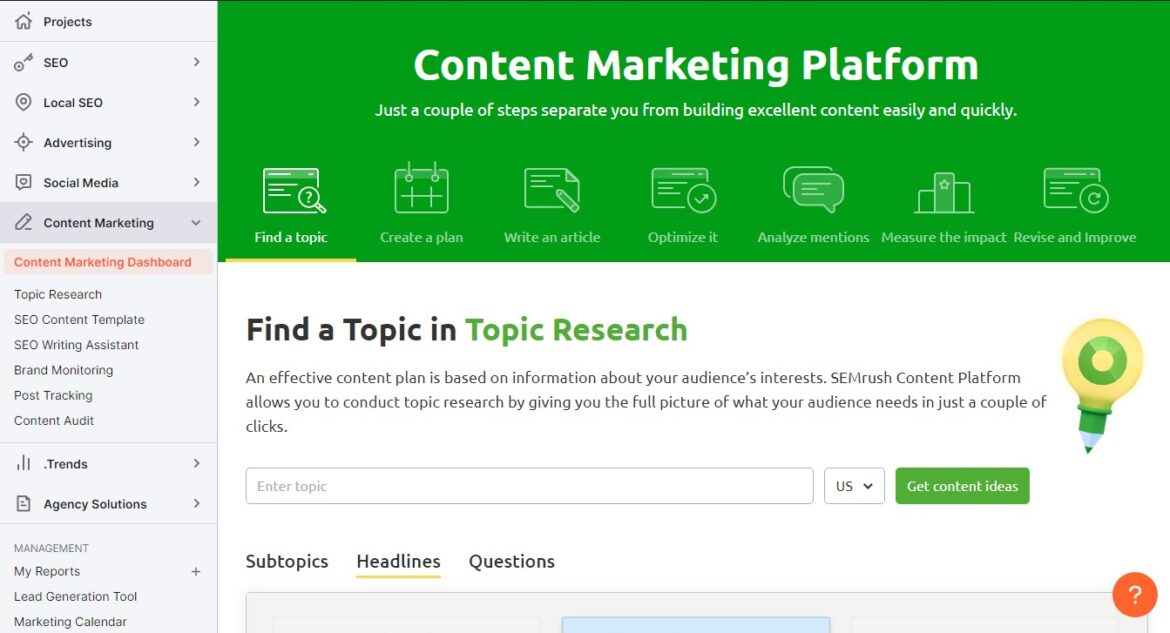
It would be great if we could just paste a link into our post and get these suggestions. However, the tool comes as a WordPress plugin and an add-on for Google docs and Microsoft word.
These tools help us write posts on different platforms like Google docs and Microsoft word, which is helpful for writers who prefer to write on those platforms.
You can try SEMRush’s content marketing tool by trying to write one free article for a keyword your want to target. It offers you a wide range of features within the content writing platform to create the best article that ranks.
Position Tracking
Position tracking or rank tracking helps your monitor the performance of your website in search engines for a specific keyword. Semrush offers a free plan that allows you to see how your site ranks for certain keywords. If you want to see how your site is performing for all keywords, you need to upgrade to a paid plan.
SEMRush offers a free tool called Rank Tracker. Enter a URL and a keyword and you’ll see how well your site ranks for that term. If you’re looking at a competitor, you can compare rankings across multiple countries.
Over time, as more data comes in, you’ll be able to see how well your efforts are working. You can also compare your own rankings to those of your competitors.
You can also get notified via email when your rankings change. You can choose to receive a summary every week, or you can specify triggers that will send you an email whenever a specific piece of content enters or drops out of the top 10.
Ultimately the Position Tracking functionality in SEMRush is very strong — no complaints here. However, I feel like there could be a lot more features available for us to use. For example, we could see what keywords our competitors are ranking for, and then use those same keywords to rank ourselves higher.
We could also see what keywords other companies are using to target similar audiences, and then use those keywords to help us get found. There are many possibilities out there, and I think SEMRush should explore all of them.
SEMRush provides SEO tools that allow you to track keyword rankings, backlinks, traffic, social shares, mentions, and more. You can even get emails when your site ranks higher or lower than others for certain terms.
Ultimately, the position tracking functionality in SEMrush is very solid — no complaints here. However, if you’re looking for something a bit more robust, there are other tools out there that might fit your needs better. I’ve listed my top picks below.
Organic Traffic Insights
This tool combines your Google Analytics, Google Webmaster Tools, and SEMRush data all into one dashboard. This includes data such as keyword analytics results as CTR, session duration, and volume with organic keyword rankings found by SEMRush and Google Search Console.
With this integration, you can easily identify which keywords aren’t performing well for your site, and then use that information to improve your keyword strategy.
A comprehensive dashboard to monitor a website’s organic search performance
Find out which keywords are not provided by Google Analytics
Analyzing desktop, mobile, and tablet traffic
Geographic traffic analysis
It’s easy to integrate with Position Tracking.
It helps you better understand what’s happening on your website and improves your SEO strategies based on statistics. Planning out an optimized SEO campaign is extremely difficult if you don’t know your keyword portfolio.
That being said, organic traffic insights is a great tool because you can combine data from Google Analytics, Google Search Console, and SEMRush into one place.
With data you can rely on, it’s easier to adjust your SEO page optimization strategy according to what works best for your business.
If you don’t know which keywords aren’t provided for your competitors, then you can use them to help improve your own rankings. This can be another way to beat your competition on search.
Link Building in SEMRush
SEMRush Link Builder helps you get links and develop a robust link building strategy. You can find out who your competitors are and then use those domains to create backlinks.
Backlinks are links on another website that points to your own site. Search engine crawlers will follow those links and index your pages, helping your page rank higher.
SEMRush is a free keyword research tool that helps you find out what other websites are ranking for specific search terms. It also gives you some very useful reporting features, including an option to see all the links pointing to your website. You can even send automated emails to potential link partners through the tool.
SEMRush is also offering a lot more than just email outreach. You can see all your links, along with any backlinks pointing to your site. You can also export your list of backlinks and compare them against other sites. You can even download them directly to Excel.
SEMRush’s link-building tool is great because it lets you find out who you can ask for a link from, or build a relationship with for your link-building exercise. With tools like backlink analytics, backlink audit, link building tool and bulk backlink analysis, you are in good hands with SEMRush.
Let’s take a look at the tools you can use for link building on SEMRush.
Backlink Analytics
Backlinks are important because they help Google understand what your website is all about. If you have lots of backlinks pointing to your website, then Google will assume that your site is relevant to the topic of the page linking to it.
Backlinks also help Google rank websites higher in search engine results pages (SERPs) since they indicate popularity. Backlink analytics allows you to monitor backlink types, link attributes, and you can use an advanced filter to find the information you are searching for.
SEMRush’s backlink analytics provides an easy way to see what other sites link to your website. You can search for any keyword or related keywords due to your industry and see what websites are linking to them. You can even check out the anchor text used in those links.
SEMRush’s backlinks come from a number of sources including Google, Wikipedia, Twitter, Facebook, Bing and Yahoo. These links are then filtered through an algorithm to ensure only relevant links are included. This means that the accuracy of SEMRush’s backlinks will vary depending on the source of the links.
For example, if you search for a specific keyword using Google, you’ll get a lot of results. However, if you search for the same keyword using another search engine like Bing, you won’t get nearly as many results. If you’re looking at a competitor’s site, you may see a different amount of backlinks compared to what we see.
I have had the pleasure of experimenting with a few SEO tools like SE Ranking, Ubbersuggest, SEO Powersuite, and more. But I find SEMRush to be at the top compared to these SEO tools because it houses more features.
Now since we have covered the backlink analytics feature, let’s take a look at another important feature, the backlink audit.
Backlink audit
You can find backlinks pointing to your website by using the backlink audit feature. You will get the information you need related to your pages about which links are pointing to them. If you find toxic links you may upload the links to Google Webmaster to mark them as spammy links.
When auditing your site’s backlink profile, SEMRush shows you good links and toxic links coming to your website.
You can then report this list to submit to Google as a Disavow file. These are usually sites that are selling products or services, or sites that are just trying to get traffic.
Backlinks are important when it comes to SEO. You need to get as many as possible. But, getting backlinks is not easy.
There are many ways to acquire quality backlinks. One of those ways is using a link builder like SEMRush. Using a tool like SEMRush, you will be able to see what kind of backlinks are available.
SEMRush’s backlink analytics provides an easy way to see what other sites link to your website. You can search for any keyword related to your industry and see what websites are linking to them. You can even check out the anchor text used in those links.
SEMRush’s backlinks come from a number of sources including Google, Wikipedia, Twitter, Facebook, Bing and Yahoo. These links are then filtered through an algorithm to ensure only relevant links are included. This means that the accuracy of SEMRush’s backlinks will vary depending on the source of the links.
You can also create an account and start creating backlinks. Once you have enough backlinks, you can submit them to Google. When you do this, Google will check if your website is safe. If it isn’t, it won’t let you rank high. So, the best thing to do is to avoid getting caught by Google.
It is important to note that there are many different types of link spam and that not all link spammers are bad people.
There are also many different ways to identify if a site is a spammer. Some SEOs feel that using a tool like SEMRush is an effective way to spot link spam. Others believe that manually reviewing sites and looking for patterns is a better method.
Google’s own webmaster trends analyst John Mueller isn’t a big fan of the concept of “bad links” either, or the tools that help identify them. He says it’s rare for link disavows to lead to a positive effect on search results.
But if you really must get rid of bad links, he recommends using a tool like Majestic SEO.
Broken link building
Broken links are an important part of link building for search engine optimization. A broken link is a page that no longer exists. When you see a broken link, there are two things you should do:
Create the content that the dead page used to point to
Ask other websites that are linked to the dead page to change those links to your website instead. It’s even greater if you already have the content on your site.
This approach lets you build up new backlinks automatically. As mentioned previously, the more backlinks that point to a page, the better its SEO score will be. SEMRush’s broken links feature is easier to get at than I’d like, though.
To use it, simply go to the ‘backlinks’ tab, select ‘broken links’, choose the URL you want to check and then export the results. You can then sort and filter them to see all the 404 errors. SEMRush is a great tool for finding these links.
It’s quite easy to import your broken link report into SEMRush. Simply go to the “Tools” tab at the top of the page, then select “Import Broken Links”.
You’ll need to enter the URL of your broken link report, along with any additional information you’d like to add about each broken link. Once imported, you can use the same “Broken Links” tool to identify potential opportunities for outreach.
Site Auditing (Using the Site Audit Tool)
Semrush is an SEO tool that helps you get found online. It provides insights into your website’s health, helping you identify areas that need improvement.
You can check your rankings, see what keywords you’re targeting, and even compare your competitors’ backlinks. There are also tools to help you discover duplicate content, fix broken links, and optimize images and videos.
You’ll get an overview of all the issues you need to fix, along with suggestions for what needs to happen next. If you’re looking to tackle a specific issue, you can click through to see exactly what needs to be done.
You can even assign each task to someone else, so you can keep track of who’s doing what. And if you’d like to share your progress with friends and family, you can add comments to each task, letting everyone know what you’ve accomplished so far.
I especially like SEMRush’s on-page SEO tool, which scans your entire site and gives you actionable advice for improvement for each page. These can include suggestions on which keywords to add to the content. Steps you can take to make pages appear as a Google featured snippet.
How to improve your body copy. Which websites to approach for backlinks. Length of content. Internal linking strategies. Another thing that’s great about SEMRush’s Site Auditing Features Is That It Doesn’t Just Tell You What Things To Do, It Tells You Why You Should Do Them.
SEMRush offers an incredible amount of information, including keyword research, backlink analysis, competitor research, and even a detailed full site health audit.
You can also see what keywords your competitors rank for, and you can get a breakdown of all the traffic sources driving them. There are plenty of other features, but those are the ones we think are the best.
Interface and ease of use
The SEMRush interface is similar to those offered by competitors like Moz and Ahref’s, comprising a menu of tools on the left and a dashboard on the right, providing a seamless user experience.
The menus are organized into useful categories — competitive research tools, keyword research tools, link building tools, rank tracking tools, on-page SEO tools and reporting tools.
SEMRush is an SEO tool that provides a lot of useful data about your website. You can see what keywords are driving traffic to your site, what pages are ranking well, and even what countries your visitors come from.
There is also a lot of data available about your competitors, including their backlinks, keywords, and social media presence.
SEMRush works well on desktops and laptops, but I’d like it to work better on phones and tablets. As it stands, it doesn’t respond well to touchscreens and requires lots of scrolling and zooming to get around.
On the plus side, there are apps available from SEMRush that let you track your location using GPS or Wi-Fi signals. It would be better though if it also allowed you to access some of the other key features of the service.
Overall, SEMRush’s interface works well and is easy to use. However, you’ll need to be using a PC instead of a mobile device to get all the benefits of its features.
The ‘SEMRush Sensor’
SEMRush offers several tools that help you understand what’s going on in the world of online marketing, including monitoring ranking fluctuations. One of them is the SEMRush Sensor. This tool monitors changes in Google’s ranking system and alerts you if there’s anything unusual happening.
You can then compare those changes against other metrics like organic traffic, social media mentions, and backlinks to see whether they correlate with the change.
SEMRush Sensors provide global or niche volatility figures, and you can even set up your own personal sensor.
This is based on keywords you’ve entered for ranking tracking purposes — if there is any major fluctuation in your search rankings, the Personal Sensor will let you know about it.
Pricing and Value for Money
Compared to the other types of SaaS apps, SEO tools like SEMrush can be very expensive. That’s understandable though because you’re not just paying to get the software itself, you’re also paying for access to lots of data, including a ton of competitor intelligence.
SEMrush offers three different subscription plans:
Pro plan: $119.95 per month.
Guru: $229.95 per month.
Business: $449.95 per month.
Discounts of up to 17 per cent are available if you pay ahead for a year.
You can try out the service for free for seven days. If you like what you see, you can upgrade to a premium account. You’ll get unlimited reports per month, but there’s also a monthly subscription option.
Users per plan
SEMRush charges are extra for additional users. You can add additional users with different login credentials under your account. It’s an efficient and secure way of organizing teamwork in SEMRush.
One of the worst things about SEMRush’s pricing scheme is that all plans (even the $449.95 Business plan) only include one user account.
If you want to give more than one person in an organization access to SEMRush, then you’ll need to pay an additional fee for each user.
Compared to all SEMRush’s competitors, which generally increase their seat count as you go down the price ladder (or charge more for fewer seats), SEMRush offers a better value for money.
If this is an issue for your business, you might want to consider purchasing a ‘Custom’ plan. It allows you to negotiate a price for an off-the-shelf solution that includes a certain number of features.
SEO Projects
The total number of projects that you can create. Projects allow you to gather all the necessary data regarding the performance of your site so you can develop an efficient marketing strategy.
You need to be aware that there are limits to what you can do with your free account. You can only have 10 projects active at any time. If you exceed this limit, then you will need to upgrade to a paid subscription.
Each plan comes with different limits. For example, the basic plan allows you to have five projects active at once while the guru plan allows you to have 15 projects active at once.
If you’re doing a lot of SEO at once or analyzing your competitors’ websites, then you might not be able to keep up with all the changes. That’s why it’s important to choose an engine that will allow you to easily add new features and updates.
Report requests
You can schedule the generation of reports in PDF format to be sent to multiple email addresses on an automatic basis.
SEMRush is very helpful when it comes to the number of reports you can request each day: even on their entry-level plan, they allow you to pull up to 3,000 domain analysis reports per day — this massively exceeds the 500 reports you can request per month on the Ahfes entry-level plan, for example.
As you move up the price ladder, the limits increase. For example, the SEMRush report limit increases from 10,000 daily to 50,000 daily, and the Ahrefs limit increases from 500 monthly to 2,500 monthly.
Competitive Intelligence and Addons
When you purchase a subscription to Semrush Trends, you gain access to all the features of Semrush Trends. You also get access to the following features:
Market Explorer – data on market players, the share of the market, audience age, gender, behaviour, seasonal peaks, trends, etc.
Traffic Analytics – visitor engagement, traffic sources (desktop/mobile), audience overlap, historical data & geographic information.
‘eyeOn’ – A tool for monitoring when your competition publishes new content or starts advertising campaigns. You get access to all of the same metrics for free, but you get to see what your competitors are doing at any time, not just when they launch an ad campaign.
SEMRush helps businesses grow online by providing them with all the tools they need to succeed. From SEO analysis to social media marketing, SEMRush provides insights into every aspect of digital marketing.
You get an overview of your competitors, track local rankings, manage Google My Business and Facebook listings, monitor reviews, and user suggestions, and even respond to reviews directly within our interface.
The SEMRush ‘App Center’
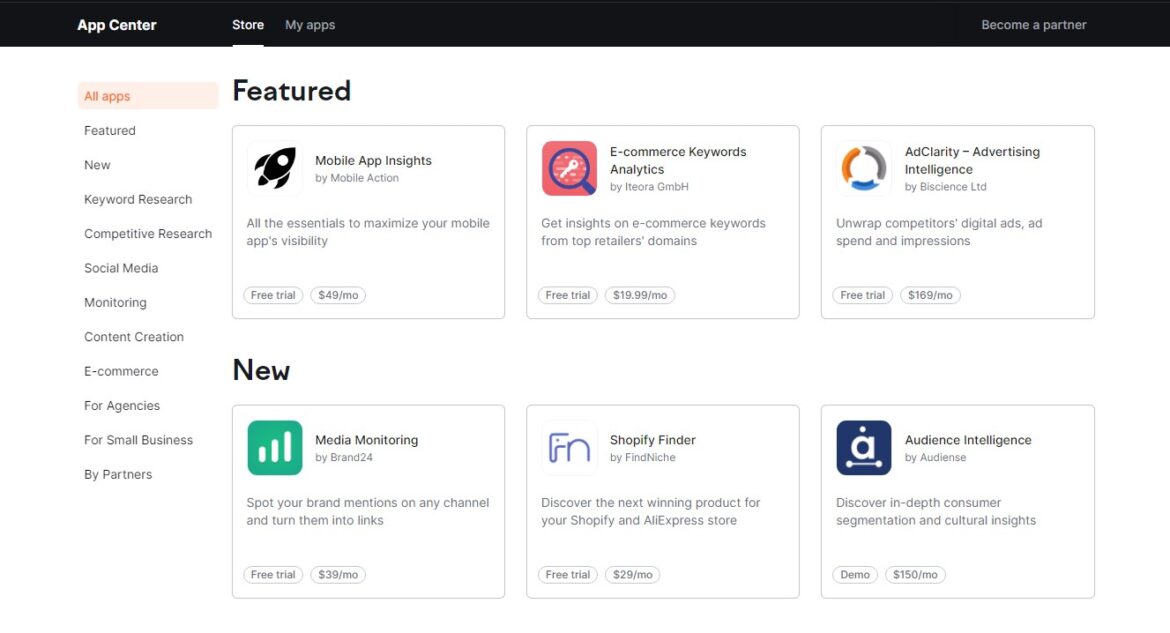
You can also invest in a third-party application from the SEMRush App Store. There are a number of apps available either built by SEMRush, or its partners to help improve the functionality of the SEO platform.
You can get even more out of your SEMRush subscription if you invest in an additional SEMRush add-on. Check the SEMRush App Center to see what’s available.
Advertising Toolkit
The SEMrush Advertisings toolkit is your one-stop shop when it comes to planning a Google Ads campaign You can access all of the resources that will help you set up and run successful advertising campaigns.
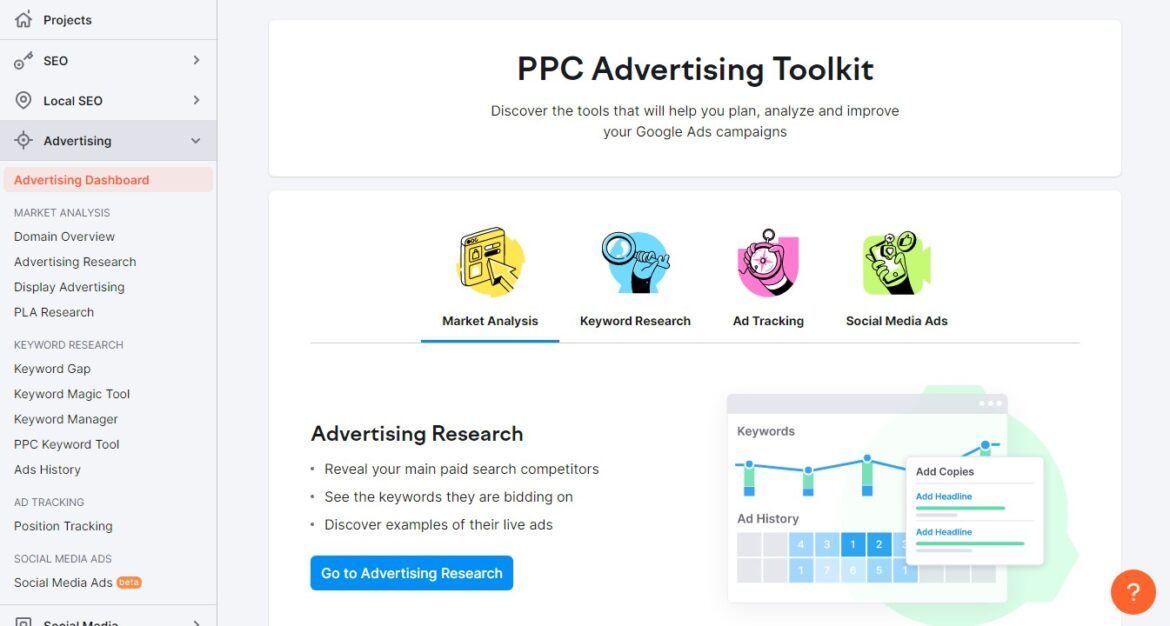
You’ll find ways to research your target market, study your competitors’ past campaigns, and set yourself up for success by creating your own ad campaign with keyword lists and ads that fit your audience.
The tools in this guide cover the following processes:
Competitive Analysis
To run a successful advertising campaign, the first thing you need to do is analyze your competitors. You’re going to need to dive deep into our tool that shows you how your competitors are using their campaigns.
This way, you’ll be able to see everything from the keywords that they are bidding on to their ad copy.
Keyword Research
To run a successful advertising campaign, the first thing you need to do is analyze your competitors.
You’re going to need to dive deep into our tool that shows you how your competitors are using their campaigns. This way, you’ll be able to see everything from the keywords that they are bidding on to their ad copy, helping you plan your PPC campaigns.
Ad Research
After analyzing your competition and finding the best keywords to target, the last step is creating ads to engage your audience. The PLA Research will allow you to analyze the visual aspects of your competitor’s advertising strategy.
If you already run Google Ads, you can import an existing campaign and restructure your keyword list in the PPC Keyword Tool.
Engaging ads are going to be what draws your audience to your ultimate goal: conversions. While writing good ads can seem like a daunting task, the help of tools such as the PLA Research can go a long way in turning your ads nightmare into a dream.
Paid advertising can be one of the best aspects of your company’s digital marketing. Targeting the keywords that are most likely to bring you the highest return on investment (ROI) can help you compete against other companies in your field.
SEMRush gives you all the information you need to plan your PPC campaigns. You get detailed stats about your competitors’ AdWords accounts, including average daily spend, budget, ad groups and keywords.
You can also see what your competitors are bidding for each keyword and compare your own bids against them. You can even create custom reports and export them to Excel.
Ad History, PPC Keyword Tool, Display advertising and PLA research are all great tools you can use to get the best results on your PPC ad campaign.
SEMRush Customer Support
SEMRush offers three ways to contact them: Phone, Email, and, Live Chat. This contrasts positively with competitors, not all of whom provide phone support. Moz and Majestic don’t offer any form of live chat support.
SEMRush makes it easy to find your contacts and get in touch with them. You can easily search for contacts using any combination of name, company, job title, location, industry, and keywords. Once you’ve found someone, you can call them directly from within the app.
If you’re looking for a specific type of contact, like an executive assistant, you can filter results by company size, industry, and position.
Frequently Asked Questions (FAQ) about SEMrush
Does SEMrush worth it?
Absolutely! SEMrush is a powerful SEO and social media toolkit that offers a wide range of features to help improve your website’s visibility and performance.
It provides in-depth keyword research, competitor analysis, backlink analytics, and much more, making it a valuable investment for anyone serious about SEO and digital marketing.
Is semrush legitimate?
Yes, semrush is a legitimate and highly reputable platform in the field of SEO and digital marketing. It is trusted by millions of users worldwide, including top industry professionals and businesses looking to enhance their online presence.
What is the weakness of SEMrush?
While SEMrush is a comprehensive SEO tool, its main weakness is its cost, which can be a bit high for small businesses or individual users. Additionally, the vast array of features can be overwhelming for beginners who might need some time to get accustomed to the platform.
Is SEMrush really free?
SEMrush offers a limited free version that allows you to access some of its features. However, to unlock its full potential and access all the tools and data, you will need to subscribe to one of their paid plans.
